Hall Lane, Houghton-le-Spring, County Durham
POSTCODE———————————-DH5 8JB
LOCATED————————————The town of Houghton-le-Spring is found roughly six miles south west of Sunderland, with venue situated half a mile south east of town centre.
ORIGINAL SITE—————————–Farm grazing land.
DATE CONSTRUCTED——————–Began May 1938.
DATE VENUE OPENED——————-November 1938.
Meaning other sports may have taken place prior to the arrival of Greyhound Racing.
FIRST MEETING—————————–November 3rd 1938.
Greyhound Racing only.
LICENSED OR INDEPENDENT———-Independent
All venues covered would have to be licensed with the government, licensed suggested in this section would refer to tracks operating under NGRC Rules.
INSIDE OR OUTSIDE HARE TYPE——Inside Sumner
Please note that the Electric Hare suggested is only a guidance and would have been in operation for a certain amount of time at this venue. Although it is not necessarily guaranteed that it was operational all the time, as other types of lure may have been used and updated as time progressed.
DISTANCES———————————–290, 480 and 675 yards.
Please note that most racing venues distances had become varied throughout the years, the ones given above were at once point set and offers only a guidance to the track size.
CIRCUMFERENCE—————————390 yards.
Please note that alterations at most racing venues throughout its existence would see that the circumference of the track would vary, the one shown above offers only a guidance to the track size.
BIG RACE NAMES—————————Feast Handicap.
STADIUM SHARED WITH——————Show jumping events.
LAST MEETING——————————-December 28th 1970.
Greyhound Racing only.
STADIUM CLOSURE DATE—————-December 1970.
Meaning other sports may have taken place after Greyhound Racing had ceased.
STADIUM DEMOLITION——————-Early 1970’s.
BUILT ON SITE——————————-Lanswood Housing Estate.
In some cases, structure’s that originally covered the venue after the stadium had been demolished, may have been themselves demolished too, so the one described is more likely to be the one which now presently covers the site.
EVIDENCE LEFT TODAY——————-Nothing known of.
FURTHER COMMENTS——————–Greyhound Racing in the town became popular due to the town’s Horse Racecourse closing during 1938.
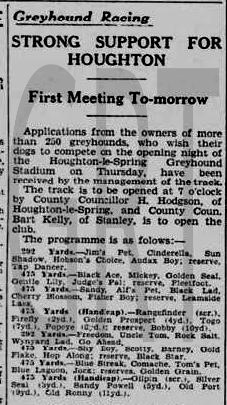
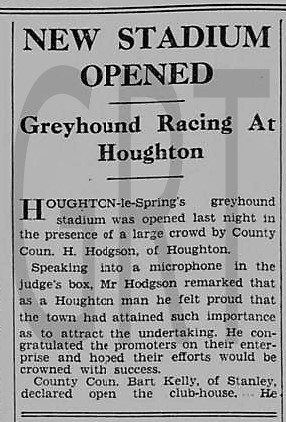
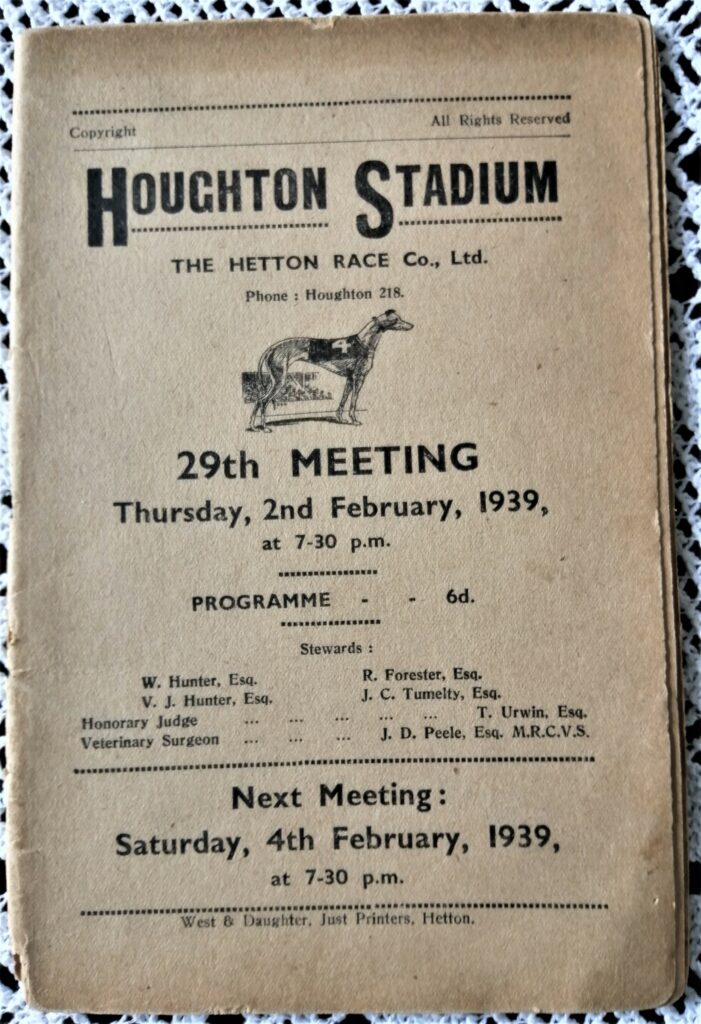
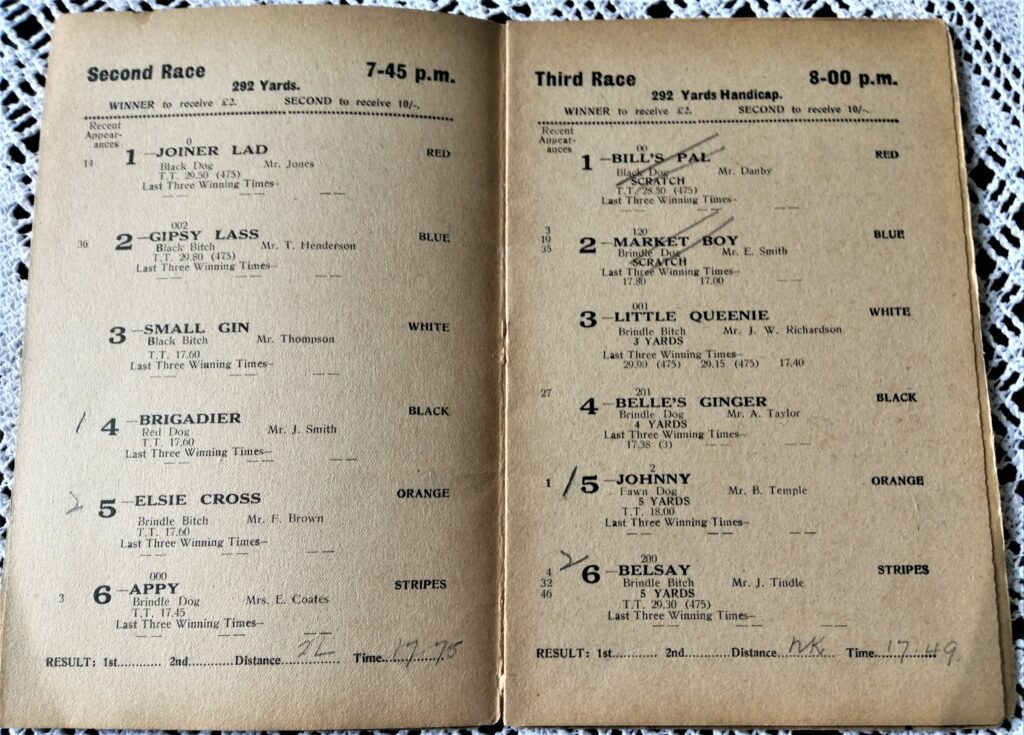







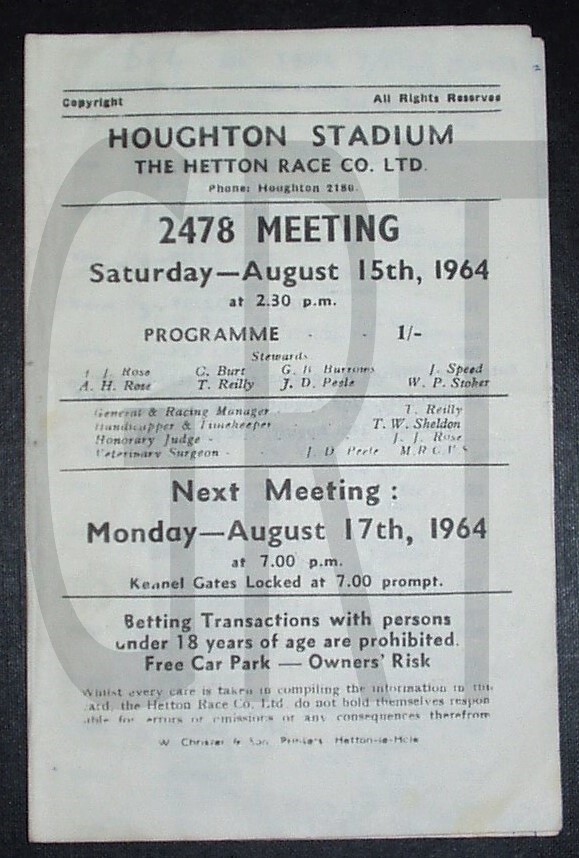
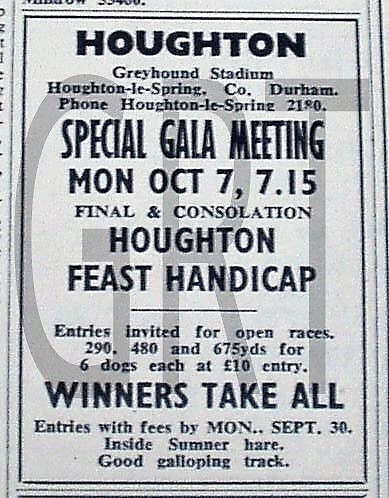


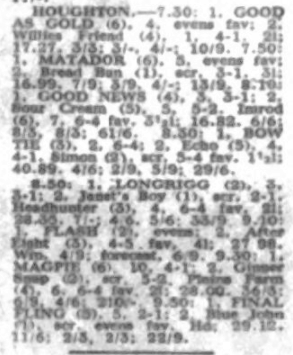
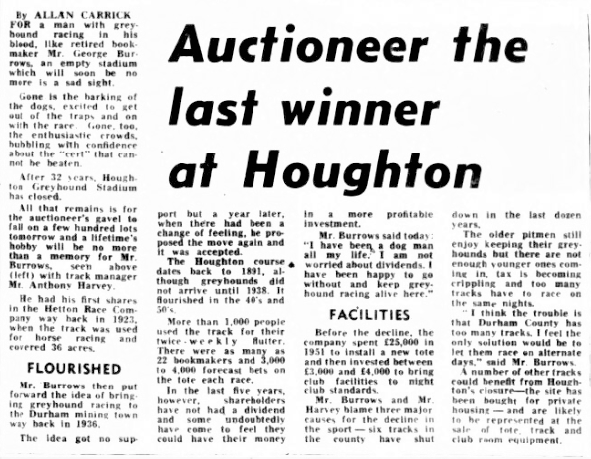
The ex coal mining town of Houghton-le-Spring lies approximately six miles south of the city of Sunderland in the North East of England. The town could once boast that it had its own horse race events, which would feature during its Feast Festival, held annually during October.
This event is mentioned due to the link the festival had with Greyhound Racing in the town. The story of the link is as follows. The Feast Festival had been part of the town’s celebrations since it originated during the twelfth century. The gathering included numerous types of entertainment, including race events of both men and animals. But it was Horse Racing that paved the way to Greyhound Racing in the town. The first horse race events took place in the early 1800’s, with the venue being moved around the town throughout the years. But it was a company known as the Hetton Race Company Limited, that became the proprietors of the Horse Racing event in 1890, and would become the same company that would promote Greyhound Racing in the town almost fifty years later.
It was the demise of the last Horse Racing event in 1938, that switched the companies ideas to promote the new sport in the town. It was during 1936 that the company first began to show their interest in dog racing, when Whippet Racing events were held on a section of grazing land just off Hall Lane, half a mile south east of Houghton’s town centre. After an application for a betting license had been approved, construction of the new track began in May 1938.
The plans of the new venue would consist of two grandstands, track lighting, kennels and a clubhouse, along with a totalisator system, predicted an estimated total cost of around £15,000. By August 1938 a newspaper advert appealed for greyhound owners to contact the management as the new independent track was almost complete and ready for operation. A startling 250 greyhounds had already graded, by the time the track was ready for its opening meeting on the 3rd of November 1938. The following day, newspaper reports confirmed that a good crowd had been entertained with an eight race event including two races over 292 yards, and six over the 475 yard trip. But success at the track came to a halt on the 1st of September 1939, this due to the declaration of the Second World War, meaning all scheduled meetings had to be cancelled, including Houghton’s.
Fortunately, the regulations became relaxed three weeks later, seeing the track resuming once again with a meeting on the 16th of September. Once given the go ahead for meetings to continue, albeit under daylight hours only, the Hall Lane venue chose to race on Monday and Saturday afternoons. Another enforced regulation, meant that patrons were not allowed admission, unless they had a gasmask in their possession. Its big race attraction during that period was the Feast Handicap, the name inherited as part of its a local festival, and by 1944 the prize money had escalated to £150 to the winner of the event. The track had an all grassed running surface, with a circumference of 390 yards. Races would consist of six greyhounds chasing an inside Sumner type hare over distances of 290, 480 and 675 yards. One of its features was a panoramic hare control box, situated within the infield of the track.
When advertising in the greyhound owner it was sometimes described as a tight track that would favour the inside runner, then some adverts would describe it as a good galloping track. Sadly, its closure came on the 28th of December 1970, with the venue having been sold for redevelopment, with a greyhound called Final Fling winning the very last race.
Today, the site is covered by a cluster of houses known as the Lawnswood Housing Estate, situated just off Hall Lane, leaving no evidence at all of the stadium ever having been there.
A photograph or memorabilia for this track is required for this page, if you can help please contact me.

Recent Comments